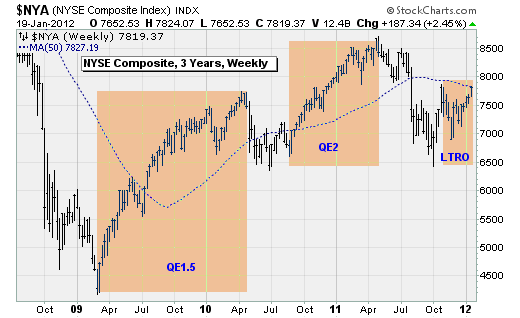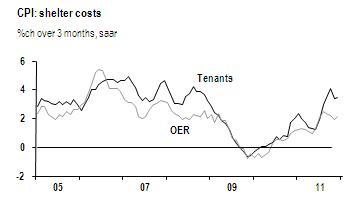Wednesday November 23, 2011
Political parties and stock returns by Sy Harding, editor Street Smart Report
The lead-up to next year’s election will bring a lot of claims from both parties. So we looked at the record over 50 and 100 years to see which political party in the White House is historically better for stocks.
I thought I’d check the historical record to make sure I don’t fall into the ‘lazy trap’ of repeating popular beliefs as fact when they might not be. I was more than mildly surprised by my research. It’s common knowledge, popular belief, historical fact, that the Republican Party is better for business, corporate profits, and the stock market – isn’t it?
Democrats are more interested in pushing socialistic programs at the expense of business – aren’t they? But wait a minute! Here's a look at the Dow’s gains and losses under Republican and Democratic Presidents over the last 50 years.
•Kennedy/Johnson (Dem) administration (1961-1965) - up 41.9%
•Johnson (Dem) administration (1965-1969) - up 8.1%
•Nixon (Rep) administration (1969 to 1973) - up 7.9%
•Nixon/Ford (Rep) administration (1973-1977) - down 0.1%
•Carter (Dem) administration (1977-1981) - down 4.1%
•Reagan (Rep) administration (1981-1985) - up 25.6%
•Reagan (Rep) administration (1985-1989) - up 79.0%
•Bush Sr. (Rep) administration (1989-1993 - up 52.3%
•Clinton (Dem) administration (1993-1997) - up 95.3%
•Clinton (Dem) administration (1997-2001) - up 67.3%
•Bush Jr. (Rep) administration (2001-2005) - unchanged
•Bush Jr. (Rep) administration (2005-2009) down 18.6%
•Obama (Dem) administration (2009 through Oct. 30, 2011) - up 36.3%
Over six Democratic terms the Dow gained 247.9%, or an average of 41.3% per term. Over seven Republican terms the Dow gained 147.1%, or an average of 21.0% per term.
Could it be? Over the last 50 years, investors have made almost double the returns under Democratic Presidents as under Republican Presidents?
I then went back 110 years to 1900. The same pattern emerged, although the difference was not as striking as it has been for the last 50 years.
From 1901 to 1961 the Dow increased an average of 36.7% per term when the president was a Democrat, and 32.1% when a Republican was in the White House.
The influence of one party or the other on the strength of the economy, business prosperity, and the stock market has clearly not been as popular wisdom suggests.
Political parties and stock returns by Sy Harding, editor Street Smart Report
The lead-up to next year’s election will bring a lot of claims from both parties. So we looked at the record over 50 and 100 years to see which political party in the White House is historically better for stocks.
I thought I’d check the historical record to make sure I don’t fall into the ‘lazy trap’ of repeating popular beliefs as fact when they might not be. I was more than mildly surprised by my research. It’s common knowledge, popular belief, historical fact, that the Republican Party is better for business, corporate profits, and the stock market – isn’t it?
Democrats are more interested in pushing socialistic programs at the expense of business – aren’t they? But wait a minute! Here's a look at the Dow’s gains and losses under Republican and Democratic Presidents over the last 50 years.
•Kennedy/Johnson (Dem) administration (1961-1965) - up 41.9%
•Johnson (Dem) administration (1965-1969) - up 8.1%
•Nixon (Rep) administration (1969 to 1973) - up 7.9%
•Nixon/Ford (Rep) administration (1973-1977) - down 0.1%
•Carter (Dem) administration (1977-1981) - down 4.1%
•Reagan (Rep) administration (1981-1985) - up 25.6%
•Reagan (Rep) administration (1985-1989) - up 79.0%
•Bush Sr. (Rep) administration (1989-1993 - up 52.3%
•Clinton (Dem) administration (1993-1997) - up 95.3%
•Clinton (Dem) administration (1997-2001) - up 67.3%
•Bush Jr. (Rep) administration (2001-2005) - unchanged
•Bush Jr. (Rep) administration (2005-2009) down 18.6%
•Obama (Dem) administration (2009 through Oct. 30, 2011) - up 36.3%
Over six Democratic terms the Dow gained 247.9%, or an average of 41.3% per term. Over seven Republican terms the Dow gained 147.1%, or an average of 21.0% per term.
Could it be? Over the last 50 years, investors have made almost double the returns under Democratic Presidents as under Republican Presidents?
I then went back 110 years to 1900. The same pattern emerged, although the difference was not as striking as it has been for the last 50 years.
From 1901 to 1961 the Dow increased an average of 36.7% per term when the president was a Democrat, and 32.1% when a Republican was in the White House.
The influence of one party or the other on the strength of the economy, business prosperity, and the stock market has clearly not been as popular wisdom suggests.






